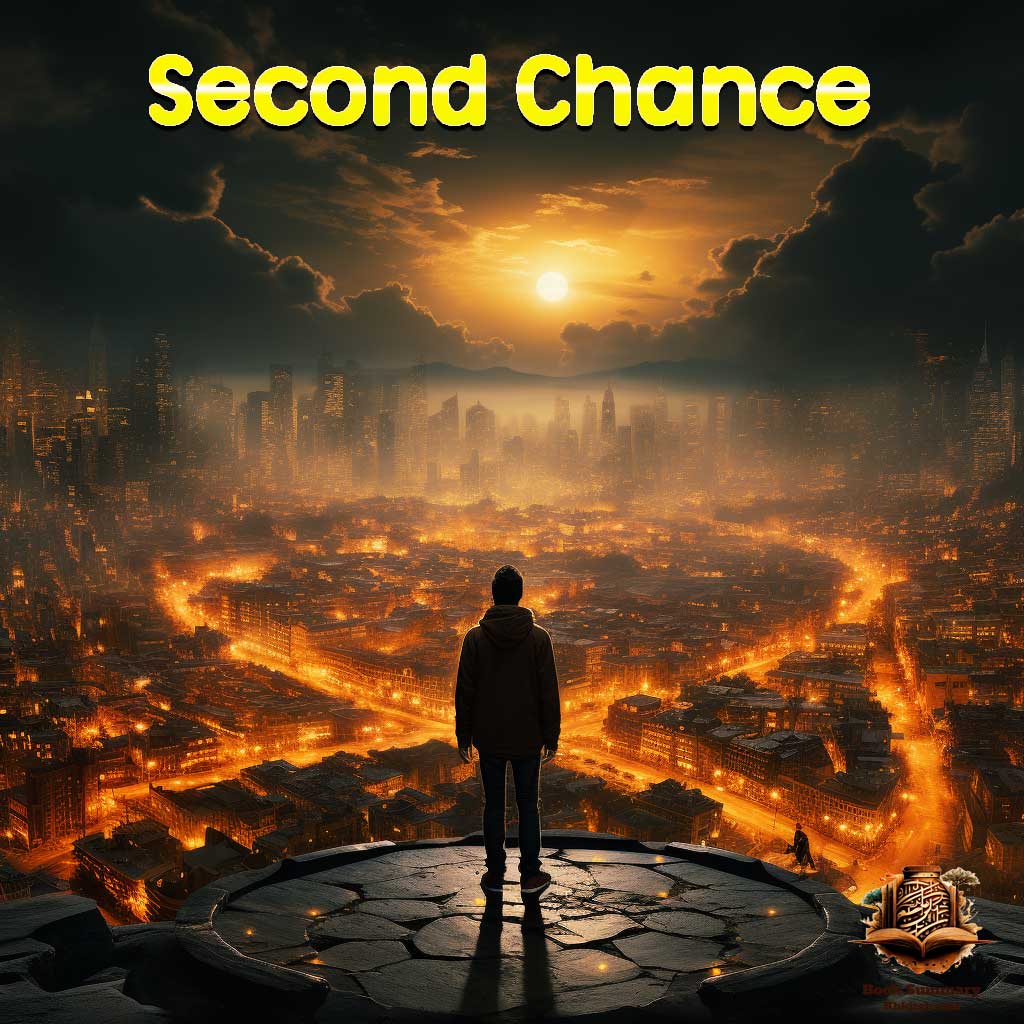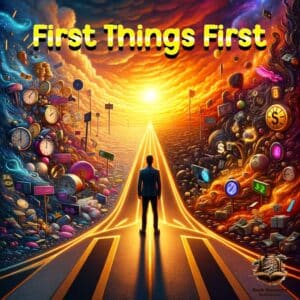Second Chance: For Your Money, Your Life and Our World Book Summary

In a world characterized by economic fluctuations and financial challenges, “Second Chance: For Your Money, Your Life and Our World” emerges as a vital resource for those striving for financial independence and wealth accumulation. Authored by the renowned writer and investor Robert Kiyosaki, the book provides insightful perspectives on historical events that molded the global economy and their ramifications on the current economic situation.
Kiyosaki emphasizes the significance of financial education and highlights common missteps people make when handling their finances. Through tales of his own life and experiences, he equips readers with tangible strategies and tools to craft a stable financial future. “Second Chance” is not just an investment guide; it’s a call to rethink prevailing educational systems and financial cultures and to adopt a new approach towards money, leading to a richer and more prosperous life.
How Have Historical Economic Events Influenced the Modern Financial Landscape?
In Robert Kiyosaki’s enlightening book, “Second Chance: For Your Money, Your Life and Our World,” a deep dive into the historical economic events provides readers with a robust framework to understand the intricate dynamics of the current global economy. These historical landmarks, as described by Kiyosaki, serve as pivotal lessons that shed light on patterns of economic growth, recessions, and recoveries.
From the Great Depression of the 1930s to the more recent 2008 financial crisis, Kiyosaki meticulously unpacks the causes, effects, and aftermaths of these cataclysmic occurrences. He draws parallels between decisions made by financial institutions, governmental policies, and subsequent market reactions. For instance, the embracing of the gold standard, its subsequent abandonment, and the impact of such monetary policies play a crucial role in shaping our contemporary economic fabric.
Through these events, Kiyosaki underscores the fact that history often has a way of repeating itself, especially when its lessons are overlooked or forgotten. The systemic vulnerabilities exposed by past crises often provide key insights into potential future challenges and how they might be mitigated. By analyzing these historical events, readers are better equipped to identify economic warning signs and make informed financial decisions in an ever-evolving economic landscape.
Moreover, “Second Chance” doesn’t just present historical facts but ties them to actionable advice. Kiyosaki emphasizes that by understanding the past, individuals can better navigate the present, laying the foundation for a more secure and prosperous financial future. This holistic approach to financial education, combining historical analysis with modern financial strategies, positions the book as an essential read for those aiming to achieve financial independence in today’s world.
Our Facebook Page – Book Summary
Why Is Financial Education the Key to Individual Success?
In “Second Chance: For Your Money, Your Life and Our World,” Robert Kiyosaki meticulously delves into the indispensable role of financial education in crafting a successful life. In today’s intricate financial landscape, possessing mere traditional academic knowledge is no longer sufficient. Kiyosaki stresses that true empowerment emerges from financial literacy, the very cornerstone of personal and professional growth.
The book highlights that most educational systems globally focus on equipping individuals with job-centric skills, often sidelining essential financial knowledge. This gap in our education leaves many vulnerable, navigating a complex financial world without the necessary tools. Such a shortfall can lead to a series of financial pitfalls, from accumulating debilitating debts to missing out on potential investment opportunities.
Kiyosaki passionately argues that understanding money – its nature, dynamics, and the systems governing it – is as crucial as any other life skill. He illustrates through personal anecdotes and practical examples how financial education can lead to better decision-making, increased wealth accumulation, and, ultimately, a more secure and fulfilling life.
Moreover, “Second Chance” isn’t merely a theoretical exploration; it’s a call to action. Kiyosaki urges readers to break free from the constraints of traditional thinking and embrace a more holistic understanding of money. By doing so, individuals not only secure their financial futures but also contribute positively to the broader economy.
In essence, financial education, as laid out in this seminal work, is not just about money. It’s about building a life of freedom, choices, and lasting success. Investing in one’s financial knowledge, as Kiyosaki emphasizes, is indeed investing in one’s future.
Business & Finance Management – Book Summary (khkitab.com)
How Do the Philosophies of “Rich Dad” and “Poor Dad” Shape Financial Outcomes?
In “Second Chance: For Your Money, Your Life and Our World,” Robert Kiyosaki delivers an enlightening analysis contrasting the ideologies of his two fathers: one he dubs “Rich Dad,” the other “Poor Dad.” This comparison provides readers with invaluable insights into the mindsets that can either propel one to financial success or keep one mired in economic stagnation.
“Rich Dad,” Kiyosaki’s mentor and the father of his childhood friend, believed in breaking the chains of traditional employment. Instead of advocating for the usual path of seeking stable jobs, he emphasized investing, creating assets, and fostering an entrepreneurial spirit. He was a staunch believer in making money work for him rather than the other way around. His lessons revolved around understanding the value of money, leveraging debts, and spotting investment opportunities. To “Rich Dad,” financial literacy was not just about numbers; it was about a philosophy of life.
On the other hand, “Poor Dad,” Kiyosaki’s biological father, was a proponent of the classic route to success. He emphasized the importance of formal education, securing a good job, and climbing the corporate ladder. His beliefs were deeply rooted in the idea that hard work within a structured system was the most reliable way to financial security. While he was well-educated and deeply respected in his field, he struggled with financial uncertainties due to his limited perspective on wealth generation.
Kiyosaki’s exploration of these contrasting philosophies serves as a mirror to society’s broader financial mindsets. Through the lens of “Second Chance,” readers are prompted to reflect on their own beliefs and actions. The book underscores the idea that one’s financial destiny isn’t just determined by external factors, but more critically, by internal choices and philosophies. The comparison between “Rich Dad” and “Poor Dad” is more than just a tale of two fathers; it’s a revelation of two paths in life, urging readers to choose wisely and take control of their financial future.
How Did the 2008 Financial Crisis Shape Modern Economic Challenges?
In “Second Chance: For Your Money, Your Life and Our World,” Robert Kiyosaki dives deep into the implications and lessons that emerged from the 2008 financial crisis. He provides a meticulous analysis of how global economic systems, banking institutions, and individual financial behaviors were impacted by one of the most defining economic events of the 21st century.
The 2008 financial meltdown, as Kiyosaki suggests, wasn’t just a hiccup in the global financial system, but a stark revelation of its inherent vulnerabilities. Banking institutions that were once considered infallible came crashing down, leading to widespread economic turmoil. The crisis brought to light the perils of over-leveraging and the dangers of complex financial instruments like derivatives, which many didn’t fully understand.
Kiyosaki also delves into the subsequent monetary policies, especially the role of central banks in a post-crisis world. Quantitative easing, a measure adopted by several central banks, involved pumping vast amounts of money into the economy. While it was seen as a necessary intervention at the time, Kiyosaki highlights the potential long-term repercussions. He argues that such policies can lead to inflationary pressures and can have profound impacts on ordinary individuals, especially those without a comprehensive understanding of monetary economics.
For individual investors and the general populace, Kiyosaki stresses the importance of financial education in navigating the modern economic landscape. The lessons from 2008, he suggests, aren’t just about understanding what went wrong but about preparing for future challenges. In an ever-complex financial world, being equipped with the right knowledge can make all the difference.
“Second Chance” doesn’t just serve as a post-mortem of the 2008 crisis but offers insights into how one can be better prepared for economic uncertainties. By understanding the intricacies of the financial system and recognizing the lessons from past mistakes, Kiyosaki believes individuals can secure a safer and more prosperous financial future.
How Have Policies Exacerbated the Wealth Gap as Depicted in “Second Chance: For Your Money, Your Life and Our World”?
In Robert Kiyosaki’s enlightening book “Second Chance: For Your Money, Your Life and Our World,” there’s a poignant exploration of the widening wealth gap. This disparity, which has seen the rich grow richer while the middle class stagnates, is a crucial theme Kiyosaki delves into, shedding light on how certain financial policies have unintentionally (or sometimes intentionally) broadened this divide.
Kiyosaki highlights that the wealth gap didn’t just happen overnight. It’s a result of decades of economic policies, some of which favored large corporations and wealthy investors over the average individual. While these policies, like tax breaks or subsidies, might seem advantageous in short-term economic boosts, they often have longer-term consequences on income distribution. For the middle class, it translates to reduced economic mobility and harder access to opportunities that the wealthy take for granted.
The author emphasizes the significance of the financial education gap, another contributing factor. The wealthy, often equipped with superior financial education and resources, can navigate the complex financial system more efficiently, leveraging tools and investments that remain out of reach for the middle class. This difference in knowledge and accessibility further accelerates wealth accumulation for the rich while leaving the middle class behind.
Moreover, Kiyosaki critically examines the aftermath of the 2008 financial crisis. Bailouts and monetary policies intended to stabilize the economy had an uneven effect. While they successfully prevented a complete financial meltdown, they also boosted asset values, primarily benefiting those who held significant assets (the wealthy) while offering minimal direct assistance to the average individual.
“Second Chance: For Your Money, Your Life and Our World” is not merely a critique but also a guide. Kiyosaki provides insights and advice on how the average person can navigate this challenging financial landscape. By understanding the mechanisms that perpetuate the wealth gap and equipping oneself with the right knowledge and skills, Kiyosaki believes individuals can take control of their financial future, irrespective of the broader economic challenges.
In sum, the expansion of the wealth gap is a multifaceted issue, intricately linked with policies, education, and market dynamics. Kiyosaki’s book serves as a critical lens, offering readers both a deep understanding of the problem and practical advice for securing their own financial futures in an increasingly polarized world.
Could We Be On The Brink Of Another Major Recession? Insights from “Second Chance: For Your Money, Your Life and Our World.”
The modern economic landscape is replete with uncertainty, and the rumblings of potential downturns are frequently heard. In his compelling work, “Second Chance: For Your Money, Your Life and Our World,” Robert Kiyosaki dives deep into the subtleties of financial markets, offering a fresh perspective on the indicators of looming recessions and the potential impacts they might carry.
Kiyosaki begins by reminiscing about the 2008 financial crisis, emphasizing its origins not merely as a series of unfortunate economic events, but as a culmination of years of unchecked financial behaviors, inadequate regulations, and a widespread lack of financial education. These elements, combined with a series of speculative bubbles, led to the meltdown.
One of the central themes of the book is the concept of recognizing patterns in the market. By studying past recessions, Kiyosaki believes that individuals can become better equipped to foresee potential future downturns. For instance, he identifies unsustainable spikes in asset values, high levels of consumer debt, and the divergence between stock market performance and the real economy as strong indicators of economic trouble ahead.
Moreover, Kiyosaki underscores the importance of central bank policies in shaping the economic narrative. He postulates that interventions, such as quantitative easing, while meant to stimulate the economy, can sometimes lead to unintended consequences like asset bubbles. These bubbles, when burst, can trigger recessions or even depressions.
But “Second Chance” isn’t all gloom. It’s also a guidebook, providing readers with strategies to safeguard their financial futures in the face of economic uncertainties. Kiyosaki advocates for diversifying investments, increasing one’s financial education, and, crucially, thinking long-term.
In conclusion, while no one can predict the future with complete certainty, understanding the signs of an impending recession is paramount. “Second Chance: For Your Money, Your Life and Our World” serves as a valuable resource in this endeavor, emphasizing that the potential for a major recession is not just a theoretical concept but a tangible risk that requires preparation and prudence.
How Can You Secure Your Financial Future? Insights from “Second Chance: For Your Money, Your Life and Our World”
In “Second Chance: For Your Money, Your Life and Our World”, Robert Kiyosaki delves deeply into the realm of personal financial strategies. Amidst global economic uncertainties and financial downturns, the author emphasizes the importance of gaining financial literacy and crafting a well-thought-out strategy to not only weather financial storms but also to build a secure and prosperous future.
Investing with Intelligence: One of Kiyosaki’s primary lessons is the importance of investing smartly. Rather than jumping on popular investment bandwagons, he advocates for a thorough understanding of one’s investments. By conducting due diligence, understanding market cycles, and staying updated with financial news, individuals can make more informed decisions, thereby reducing risks and maximizing potential returns.
Asset Building over Liability Accumulation: Kiyosaki introduces readers to the concept of assets and liabilities in a way that’s unconventional yet eye-opening. In his perspective, assets are things that put money in your pocket, while liabilities take money out. Thus, the goal is to accumulate more assets (like rental properties, stocks, bonds) and reduce liabilities (like high-interest loans or debts). Over time, a robust portfolio of assets can generate passive income, providing financial security.
Continuous Learning and Adaptation: The financial landscape is continuously evolving. New investment tools, financial products, and market dynamics emerge. Kiyosaki stresses the significance of being a lifelong learner in the realm of finance. By attending seminars, reading books, and consulting with financial advisors, individuals can stay ahead of the curve and adapt their strategies as needed.
Avoiding the Pitfalls of Consumerism: In a world driven by consumerism, it’s easy to fall into the trap of living beyond one’s means. Kiyosaki warns against the dangers of excessive spending and accumulating debt. Instead, he champions living within one’s means, saving diligently, and investing wisely.
In conclusion, “Second Chance: For Your Money, Your Life and Our World” serves as a roadmap for individuals, regardless of their current financial status. By internalizing Kiyosaki’s teachings and applying them, readers can navigate the complexities of the financial world and lay the foundation for a prosperous and secure future.
How Can You Thrive in an Unpredictable Economy? Insights from “Second Chance: For Your Money, Your Life and Our World”
The ever-evolving landscape of global economics can often be tumultuous and unpredictable. Robert Kiyosaki, in his book “Second Chance: For Your Money, Your Life and Our World,” sheds light on this complexity and offers readers a blueprint for not just surviving but thriving amid such financial challenges. Here are some core principles and guidelines drawn from the book:
Understanding Financial Education: Kiyosaki places a significant emphasis on the importance of financial literacy. He argues that conventional education often fails to impart genuine financial knowledge. To navigate the unpredictable economic terrains, one must prioritize self-education in financial principles, understanding assets and liabilities, and the dynamics of income and expenditure.
Asset Accumulation Over Debt: A foundational principle Kiyosaki introduces is the concept of accumulating assets over liabilities. In simple terms, assets are things that put money in your pocket, while liabilities take money out of it. The road to prosperity, as he sees it, is paved by the continual acquisition of assets that can generate passive income, reducing reliance on a fixed salary or wage.
Being Market Agile: The financial markets are continually evolving. New investment instruments emerge, economic policies shift, and global events can turn markets upside down overnight. Kiyosaki emphasizes the importance of staying updated, being flexible, and adapting one’s investment strategy based on current market realities. This agility can be the difference between capitalizing on opportunities and succumbing to financial downturns.
Diversification as a Safety Net: Never putting all your eggs in one basket is a recurring theme in Kiyosaki’s teachings. By diversifying investments across different asset classes and sectors, one can hedge against potential losses. This approach ensures that even if one asset or investment underperforms, others can compensate, ensuring overall portfolio growth.
Continuous Learning and Networking: Kiyosaki stresses the role of continuous learning in financial success. Whether it’s attending seminars, reading up-to-date literature, or networking with successful investors, keeping oneself informed is crucial. He believes that surrounding oneself with like-minded individuals can open doors to opportunities and insights that might not be available otherwise.
Taking Calculated Risks: Every financial endeavor comes with its set of risks. However, Kiyosaki believes in taking calculated risks. It involves meticulous research, understanding the risk-reward ratio, and sometimes going against conventional wisdom. By doing so, individuals can tap into opportunities that the majority might overlook.
In conclusion, “Second Chance: For Your Money, Your Life and Our World” is more than just a book about money. It’s a guide on how to think, strategize, and act in a world riddled with financial uncertainties. Adhering to its principles can pave the way for not just economic stability, but prosperity even in the most challenging times.
Can Rethinking Prevailing Systems Revolutionize Our Financial Future? Insights from “Second Chance: For Your Money, Your Life and Our World”
The current financial and educational landscapes, shaped over decades, have deeply influenced our beliefs and attitudes towards money. Robert Kiyosaki, in his thought-provoking book “Second Chance: For Your Money, Your Life and Our World”, challenges readers to re-examine these established systems and their underlying presumptions. Here are some principal takeaways:
1. The Fault in Traditional Education: Kiyosaki underscores that the conventional education system predominantly equips students with skills for employment but lacks in providing genuine financial wisdom. Often, this results in graduates being unprepared for the real-world financial challenges they encounter.
2. Financial Misbeliefs Perpetuated by the System: Our societal norms, often backed by the educational system, perpetuate the belief that a steady job and saving money are the cornerstones of financial security. However, Kiyosaki suggests these might be outdated principles in today’s rapidly evolving financial world.
3. The Rise of the Entrepreneurial Spirit: Contrary to the job security belief, Kiyosaki champions entrepreneurial ventures and investing as the new avenues to financial independence. He asserts that fostering an entrepreneurial mindset can better equip individuals to navigate the uncertainties of the modern economic landscape.
4. Questioning the Banking System: Kiyosaki delves into the intricacies of the global banking system, highlighting its vulnerabilities. He urges readers to be skeptical of solely relying on banks for financial growth, emphasizing the significance of investing in assets that generate passive income.
5. The Impact of Technology on Finances: The digital age has fundamentally transformed the financial world. Kiyosaki points out the need to stay updated and leverage technological advancements for financial growth, instead of being left behind by clinging to old money beliefs.
6. Lifelong Learning is Crucial: One of the recurring themes in the book is the importance of continuous self-education in finance. Kiyosaki believes that constant learning and seeking mentorship can immensely benefit individuals in their financial journey.
7. Rethinking Debt: Contrary to popular belief, Kiyosaki posits that not all debt is bad. Understanding and leveraging good debt can, in fact, be a potent tool for wealth creation.
In conclusion, “Second Chance: For Your Money, Your Life and Our World” is not merely a finance book. It’s a clarion call to question, challenge, and eventually revamp the prevailing systems governing our financial beliefs. By taking heed of Kiyosaki’s insights, individuals can potentially chart a more informed and prosperous financial path in this ever-evolving world.


